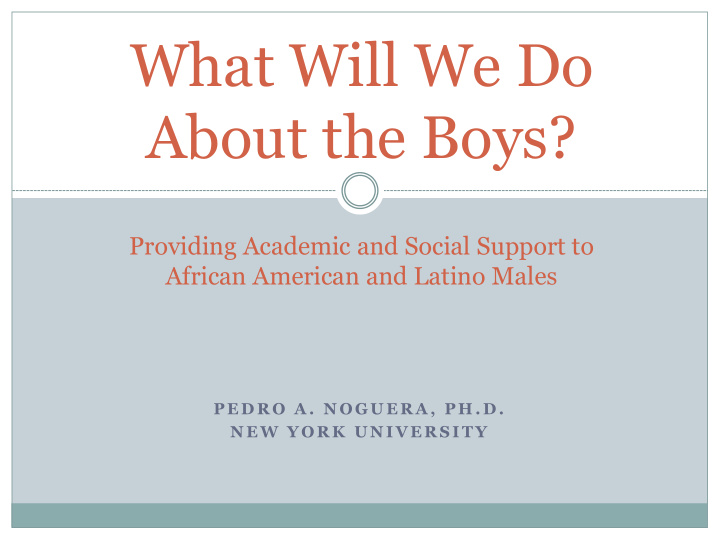



What Will We Do About the Boys? Providing Academic and Social Support to African American and Latino Males P E D R O A . N O G U E R A , P H . D . N E W Y O R K U N I V E R S I T Y
American Reading Company Contact Information Ann Homolka Account Manager for New Jersey cell: (215) 834-3804 email: ann.homolka@americanreading.com Molly Breslin Account Manager for Manhattan, Queens, SI & NJ cell: (551) 427-4254 email: molly.breslin@americanreading.com Tony Falotico Account Mgr. for Bronx, Brooklyn, Westchester, CT cell: (646) 872-3334 email: tony.falotico@americanreading.com
Six Essentials to creating an ACTION Plan: 1. Holistic and integrated 2. Evaluated regularly 3. Sensitive to diversity 4. Designed to avoid stigmatization 5. Operative at individual and systems level 6. Includes developmental systems of support
I. Understanding the Nature of the Risks Facts about Black and Latino males in school • More likely to be suspended or expelled • More likely to drop-out • More likely to be placed in special education • More likely to be missing from honors, gifted and advanced placement • More likely to be under-represented among school personnel (except as custodians, security guards and disciplinarians)
Correspondence with societal patterns facing Black and Latino Men Black males are the only segment of the US population with a declining life expectancy Adult Black and Latino males are more likely to: Be arrested, convicted, incarcerated, and executed Be unemployed and discriminated against in labor market To suffer from colon cancer, heart disease, HIV/AIDS To be murdered or to become a victim of violence To be denied the right to vote To be under represented in professional careers, over represented in military, sports and entertainment
Key Question: What is there about being a male of color in American society that causes disproportionate rates of failure?
Structural and Cultural Obstacles Structural Cultural Lack of jobs Negative peer influences Concentrated poverty Negative racial stereotypes Crime infested neighborhoods Dysfunctional schools Early exposure to Families in distress violence and trauma Exposure to negative Lack of access to good media and pop culture health care influences Toxins in the environment
Agency: The power of choice and free will Paulo Freire - Humans vs. animals, nature vs. culture Empowerment through critical consciousness - reading the world, recognizing human capacity to intervene Developing resilience – asset-based teaching, mentoring, expanding opportunities
Why Aren’t Schools More Effective at Providing Support to Males of Color? Too much emphasis on control and passive learning Too punitive in the approach to discipline Too much focus on achievement not enough focus on development Lack of adult role models
Development Matters Boys mature more slowly than girls Boys need to focus on developing literacy skills and oral communication Boys need help developing social and emotional intelligence Engaging boys in leadership, community service and other forms of social responsibility can help foster agency
Understanding the Dilemma of Masculinity Masculinity in US constructed around power, dominance, ability to provide African American, Latino and working class white males more likely to see masculinity as being at odds with intellectual achievement Males need help developing social and emotional intelligence
II. Schools must counter structural and cultural obstacles through a positive school culture Demystify school success: Teach study skills, organization Show them what excellent work looks like Use discipline to build character and personal responsibility Punitive vs. preventative strategies Teach code switching Speech, dress, demeanor Code of the streets vs. the code of the school
Draw on Cultural Resources Positive family, peer, community socialization Traditions, rituals and practices Funds of knowledge- Luis Moll Reinforce fundamental core values Provide a culturally salient learning structure Rituals, community building Incorporate positive elements of popular culture
Implement change in the culture of schools Create a school culture that Challenges stereotypes – Excellence Charter School Focuses on values and norms – Urban Prep: more powerful than culture of the streets Adopt rituals and practices that reinforce core values – Fredrick Douglass Academy Town hall meetings Student conduct panels
III. Implement changes in the organization and operation of schools Promote strong teacher-student relationships: Teach the way students learn – Boykin: teaching with verve Make curriculum culturally relevant: Cummins: empowering or disabling Avoid concentrating too many students with challenges together Develop advisory programs Help students plan for the future Pro-active mentoring Emotional and psychological support
Encourage Classroom Collaboration Increase on-task learning and collaboration Promote student accountability, ownership and responsibility Encourage student voice, personalization and choice
Other school-based interventions Develop early intervention systems 3 rd grade 6 th grade 8 th grade Assess learning and behavior challenges, monitor progress Use extra-curricular activities to keep kids engaged Utilize after school and summer programs to enhance learning
Work with Parents and Community Develop partnerships with churches and community based organizations to address challenges facing youth – gangs, safety, etc Make school welcoming to parents Train teachers how to conduct conferences Establish relationships before problems occur Hire Black and Latino males in professional roles
Cultivate Agency: Influencing the choices that students make Educate them about their history and culture - Paul Robeson Institute Provide opportunities for community service, activism and leadership development - Urban Arts Utilize community-centered problem-posing curriculum Channel the energy, don’t crush it Sports, music, art Teach boys to understand their emotions and to deal constructively with the anger Emotional intelligence
Build a safety net to support boys of color Extended Learning Health Safety, and Mentors Nutrition Family Community Partners Engagement
Six Essentials: 1. Holistic and integrated 2. Evaluated regularly 3. Sensitive to diversity 4. Designed to avoid stigmatization 5. Operative at individual and systems level 6. Includes developmental systems of support
Recommend
More recommend